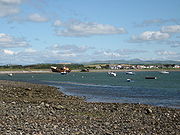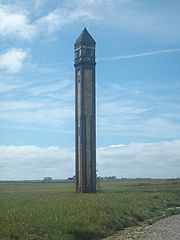
Rampside
Encyclopedia

Cumbria
Cumbria , is a non-metropolitan county in North West England. The county and Cumbria County Council, its local authority, came into existence in 1974 after the passage of the Local Government Act 1972. Cumbria's largest settlement and county town is Carlisle. It consists of six districts, and in...
, England
England
England is a country that is part of the United Kingdom. It shares land borders with Scotland to the north and Wales to the west; the Irish Sea is to the north west, the Celtic Sea to the south west, with the North Sea to the east and the English Channel to the south separating it from continental...
, located a few miles south-east of the town of Barrow-in-Furness
Barrow-in-Furness
Barrow-in-Furness is an industrial town and seaport which forms about half the territory of the wider Borough of Barrow-in-Furness in the county of Cumbria, England. It lies north of Liverpool, northwest of Manchester and southwest from the county town of Carlisle...
, in the north-western corner of Morecambe Bay
Morecambe Bay
Morecambe Bay is a large bay in northwest England, nearly due east of the Isle of Man and just to the south of the Lake District National Park. It is the largest expanse of intertidal mudflats and sand in the United Kingdom, covering a total area of 310 km².-Natural features:The rivers Leven,...
on the Furness peninsula
Furness
Furness is a peninsula in south Cumbria, England. At its widest extent, it is considered to cover the whole of North Lonsdale, that part of the Lonsdale hundred that is an exclave of the historic county of Lancashire, lying to the north of Morecambe Bay....
.
History
There is evidence that the village was inhabited as early as 1292, in the records of the monks of Furness AbbeyFurness Abbey
Furness Abbey, or St. Mary of Furness is a former monastery situated on the outskirts of the English town of Barrow-in-Furness, Cumbria. The abbey dates back to 1123 and was once the second wealthiest and most powerful Cistercian monastery in the country, behind only Fountains Abbey in North...
, though Viking
Viking
The term Viking is customarily used to refer to the Norse explorers, warriors, merchants, and pirates who raided, traded, explored and settled in wide areas of Europe, Asia and the North Atlantic islands from the late 8th to the mid-11th century.These Norsemen used their famed longships to...
and Roman
Roman Britain
Roman Britain was the part of the island of Great Britain controlled by the Roman Empire from AD 43 until ca. AD 410.The Romans referred to the imperial province as Britannia, which eventually comprised all of the island of Great Britain south of the fluid frontier with Caledonia...
artefacts have been found in the village's church. As well as agriculture
Agriculture
Agriculture is the cultivation of animals, plants, fungi and other life forms for food, fiber, and other products used to sustain life. Agriculture was the key implement in the rise of sedentary human civilization, whereby farming of domesticated species created food surpluses that nurtured the...
, the village acted as a small port, with shipping trade coming to Furness Abbey through Roa Island
Roa Island
Roa Island lies just over half a mile south of the village of Rampside at the southernmost point of the Furness Peninsula in Cumbria, though formerly in the area of Lancashire north of the sands. It is located at . It is one of the Islands of Furness in northern England. It has an area of about...
, which itself was defended by the fortified Piel Island
Piel Island
Piel Island lies half a mile off the southern tip of the Furness Peninsula in the administrative county of Cumbria, though historically within Lancashire north of the sands. It is located at . It is one of the Islands of Furness in Northern England...
, both around one mile south of Rampside.
Thomas Lawson
Thomas Lawson (botanist)
-Life:Born 10 October 1630, he was younger son of Sir Thomas and Ruth Lawson. He is identified as Thomas Lawson, born at Lawkland, near Settle, Yorkshire, and educated at Giggleswick, who was admitted sizar of Christ's College, Cambridge 25 July 1650 , graduating B.A. 1655–6.Lawson became an adept...
, a herbalist and botanist, was born at Rampside in 1630 and became minister at the village church. He invited George Fox
George Fox
George Fox was an English Dissenter and a founder of the Religious Society of Friends, commonly known as the Quakers or Friends.The son of a Leicestershire weaver, Fox lived in a time of great social upheaval and war...
to preach from the pulpit after one Sunday service, and subsequently became a Quaker himself in 1653. He published various religious works and died in 1691.

Bathing
Bathing is the washing or cleansing of the body in a fluid, usually water or an aqueous solution. It may be practised for personal hygiene, religious ritual or therapeutic purposes or as a recreational activity....
resort; at the time, it was larger than Barrow-in-Furness, which was still a small hamlet. The poet, William Wordsworth
William Wordsworth
William Wordsworth was a major English Romantic poet who, with Samuel Taylor Coleridge, helped to launch the Romantic Age in English literature with the 1798 joint publication Lyrical Ballads....
, is known to have frequented the village at this time. His memory of his time at Rampside and his view towards Piel Castle
Piel Castle
Piel Castle also known as Fouldry Castle, is a castle situated on the south-eastern point of Piel Island, 1 km off the southern tip of the Furness Peninsula, protecting the deep water harbour of Barrow-in-Furness in north west England.....
led him to write the following in 1805:
-
- 'I was thy neighbour once, thou rugged Pile!
- Four summer weeks I dwelt in sight of thee:
- I saw thee every day, and all the while,
- Thy form was sleeping on a glassy sea'
In 1840, development began on a causeway to Roa Island, resulting in a rail ferry from Fleetwood
Fleetwood
Fleetwood is a town within the Wyre district of Lancashire, England, lying at the northwest corner of the Fylde. It had a population of 26,840 people at the 2001 Census. It forms part of the Greater Blackpool conurbation. The town was the first planned community of the Victorian era...
to the island, the trains then passing through Rampside to get to Barrow and the southern Lake District
Lake District
The Lake District, also commonly known as The Lakes or Lakeland, is a mountainous region in North West England. A popular holiday destination, it is famous not only for its lakes and its mountains but also for its associations with the early 19th century poetry and writings of William Wordsworth...
. This service became obsolete with the railway barges linking Ulverston
Ulverston
Ulverston is a market town and civil parish in the South Lakeland district of Cumbria in north-west England. Historically part of Lancashire, the town is located in the Furness area, close to the Lake District, and just north of Morecambe Bay....
and Lancaster, and the causeway soon became a road.
On February 15, 1865, a small shallow earthquake estimated in recent times to have been 8 on the Richter Scale, caused serious damage in Rampside.
Present day
In recent years, Roa Island and Rampside have retained their close links to the sea, with sailing and windsurfing popular in the surrounding waters.Rampside is also home to the Rampside Gas Terminal
Rampside Gas Terminal
Rampside Gas Terminal is a gas terminal situated in Barrow-in-Furness, Cumbria on the Irish Sea coast. It connects to gas fields in Morecambe Bay.-History:...
and Roosecote Power Station
Roosecote Power Station
Roosecote Power Station is a gas-fired and former coal-fired power station, situated in the Roosecote district of Barrow-in-Furness in Cumbria, North West England. The current gas-fired station was the first CCGT power station to supply electricity to the United Kingdom's National Grid.-Coal-fired...
, where gas from the Morecambe Bay and Irish Sea
Irish Sea
The Irish Sea separates the islands of Ireland and Great Britain. It is connected to the Celtic Sea in the south by St George's Channel, and to the Atlantic Ocean in the north by the North Channel. Anglesey is the largest island within the Irish Sea, followed by the Isle of Man...
gasfields comes onshore. This, and commuting into Barrow, are the main sources of modern-day employment in Rampside.

